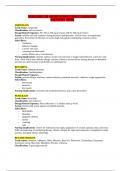NURS 316L- OB MEDICATION CARDS LABOR AND
DELIVERY MEDS
AMPICILLIN
Trade Name: Ampicillin
Classification: anti-invectives
Dosage/Route/Frequency: PO 250 to 500 mg q 6 hours, IM/IV 500 mg q 6 hours
Action: inhibits cell wall synthesis during bacterial multiplication. Used to treat. uncomplicated
gonorrhea. Prevention of infection in certain high-risk patients undergoing cesarean section.
Side Effects:
Confusion
behavior changes
a severe skin rash
urinating less than usual
seizure (black-out or convulsions).
Nursing Implications: monitor sodium. monitor for bacterial or fungal superinfection. watch for rash,
fever, chills which may indicate allergic reaction. Obtain a history before starting therapy to determine
previous use and reactions to penicillins or cephalsporins.
BENADRYL
Trade Name: Diphenhydramine
Classification: Antihistamines
Dosage/Route/Frequency:
Action: prevent allergic reactions, motion sickness, potentiate narcotics, sedation, cough suppression.
Side Effects:
drowsiness
anorexia
dry mouth
Nursing Implications: increased risk of photosensitivity, may cause drowsiness
PENICILLIN
Trade Name: Penicillin
Classification: anti-infective
Dosage/Route/Frequency: Most infections- 1-5 million units q 4-6 hr.
Action: Bactericidal action against susceptible bacteria.
Side Effects:
SEIZURES
Diarrhea
epigastric distress
nausea
vomiting
rash
Nursing Implications: Assess for infection (vital signs; appearance of wound, sputum, urine, and stool;
WBC) at beginning of and during therapy. Observe patient for signs and symptoms of anaphylaxis (rash,
pruritus, laryngeal edema, wheezing)
BETAMETHASONE
Trade names: Betacort, Alphatrex, Bebn, Betatrex, Beta-Val, Betnovate, Celestoderm, Diprosone,
Ectosonel, Luxiq, Maxivate, Metaderm, Psorion, Valosone
Classification: Topical glucorticoid
,Dosage/Route/Frequency for population being served: Adult and child-apply to affected area; topical;
continue treatment for a few days after area has cleared
Action: Antipruritic, anti-inflammatory
Side Effects:
acne, atrophy
epidermal thinning
purpura
striae
Nursing Implications: monitor temp; if fever develops, product should be discontinued. Monitor for
systemic absorption, increased temp, inflammation, irritation
BICITRA
Trade Name: Sodium citrate/citric acid
Pregnancy Risk Category C
Classification: urinary alkalinizers
Action: reduce gastric acidity, general anesthesia for emergency c-section to reduce gastric acidity
Side effects:
diarrhea
nausea/vomiting
abdominal pain
fluid retention
swelling, tingling, numbness
tachycardia
dizziness, confusion
Nursing Implications: monitor electrolytes, especially bicarb.
CALCIUM GLUCONATE
Trade Name: Kalcinate
Classification: mineral and electrolyte replacements/supplements
Dosage/Route/Frequency: 1 gram of calcium gluconate contains 90 mg elemental calcium (4.5 mEq
calcium).
Action: Essential for nervous, muscular, and skeletal systems. Maintain cell membrane and capillary
permeability. Acts as an activator in the transmission of nerve impulses and contraction of cardiac,
skeletal, and smooth muscle. Essential for bone formation and blood coagulation.
Side Effects:
CNS: headache, tingling
CV: syncope, CARDIAC ARREST, arrhythmias, bradycardia
GI: constipation, nausea, vomiting
GU: calculi, hypercalciuria
Local: phlebitis
Nursing Implications:
PO: Monitor BP, pulse, and ECG frequently throughout parenteral therapy. May cause vasodilation with
resulting hypotension, bradycardia, arrhythmias, and cardiac arrest. Transient increases in BP may occur
during IV administration, especially in geriatric patients or in patients with hypertension.
CEFAZOLIN
Trade Name: cephalosporin
Classification: first generation cephalosporin, antibiotic
Pregnancy risk category B
Action: prophylaxis gainst infection preoperatively, high risk c section, 2nd trimester abortion
, Contraindication: hypersensitivity to cephalosporin
Nursing Implications: cautious with patient with impaired renal function or GI
disease. Monitor BUN and creatinine. Watch for superinfection, monitor I and O
Side effects:
Chills
Abdominal cramps
n/v
elevate bun and creatinine
rash
dyspnea
renal failure
impaired liver function
CERVIDIL
Generic name: Dinoprostone
Classification: oxytocicsprostglandins
Dosage/Route/Frequency: Endocervival 0.5 mg may repeat in 6 hours not to exceed 1.5 mg/24 hour.
Vaginal insert one 10 mg insert.
Action: Produces contractions similar to those occurring during labor at term by stimulating the
myometrium. Initiates softening, effacement and dilation of the cervix.
Side Effects:
amniotic fluid embolism
fever
back pain
uterine rupture
uterine hyper stimulation
Nursing Implications: Monitor amount and type of discharge. Notify healthcare professional if
symptoms of hemorrhage occur. For cervical monitor uterine activity, fetal status, and dilation and
effacement of cervix. Insert should be removed at the onset of active labor.
CLINDAMYCIN
Trade name: Cleocin
Classification: Lincosamide, Anti-infective
Pregnancy risk category: Category B
Action: Inhibits protein synthesis in susceptible bacteria by binding to the 50S subunits of bacterial
ribosomes and preventing peptide bond formation, which causes bacterial cells to die.
Indication: Treatment of serious infections caused by susceptible anaerobic bacteria. Treats vaginal
infections caused by bacteria.
Dosage/Route: (PO) Serious infections-150 to 300 mg every 6 hours. More severe infections-300 to 450
mg every 6 hours. (I.V./I.M.) 1.2-2.7 g/day in 2-4 divided doses, max 4800 mg/day.
Adverse reactions:
Fatigue, headache
Hypotension
thrombophlebitis (after I.V. injection)
Glossitis, metallic or unpleasant taste (with high I.V. doses)
Stomatitis
Abdominal pain
Diarrhea
Esophagitis




